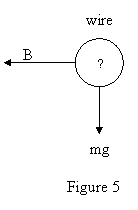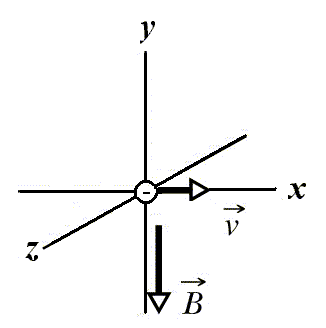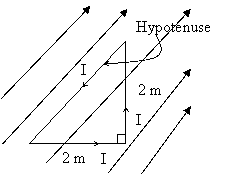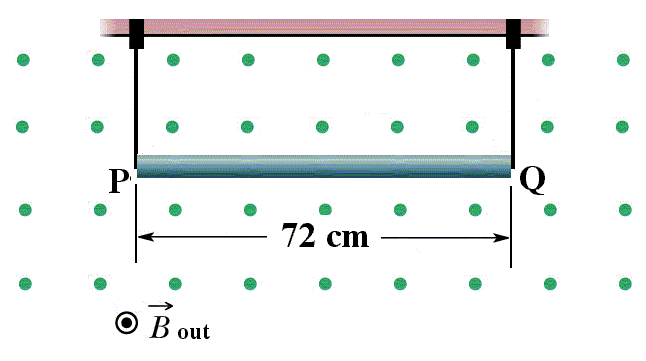The path of a charged particle in a magnetic field, when
its direction of motion is not at right angle to the
magnetic field, will be a:
a helix.
b circle.
c straight line.
d hyperbola.
e parabola.
==============================================
Question 2
An electron that has velocity
v = 3.2*10**7 i m/s
traveling parallel to a uniform magnetic field of strength
2.60*10**(-3) Tesla. The force on the electron is:
[i is the unit vectors in the directions of x]
a 6.1*10**(-15) N.
b 1.4*10**(-15) N.
c 2.3*10**(-15) N.
d 5.0*10**(-15) N.
e zero.
==============================================
Question 3
Particle #1 (of mass m and charge q) and another particle #2
(of mass 3 m and charge q) are accelerated through a common
potential difference V. The two particles enter a uniform
magnetic field B along a direction perpendicular to B. If
particle #1 moves in a circular path of radius r1, then the
radius r2 of the circular path of particle #2 is:
a r1*Sqrt(2).
b r1*Sqrt(6).
c r1*Sqrt(5).
d 2.0*r1.
e r1*Sqrt(3).
==============================================
Question 4
A closed loop has an area of 5.8*10**(-2) m**2 and carries a
current of 3.0 A. It is placed in an external magnetic field,
whose magnitude is 0.50 T, with its dipole moment initially
making an angle of 90 degrees with the external magnetic field.
How much work is done by the magnetic field as it rotates the
loop from its initial orientation to the final orientation where
the dipole moment is aligned with the field ?
a - 0.087 J
b + 0.087 J
c zero
d + 0.042 J
e - 0.042 J
==============================================
Question 5
A straight horizontal length of copper wire is located in a
place where the magnetic field of the earth B = 0.5*10**(-4)T
(see figure 5). What minimum current in the wire is needed
to balance the gravitational force on the wire?
[The linear density of the wire is 60.0 gram/m]

a 1.2*10**4 A into the page.
b 4.3*10**4 A out of the page.
c 1.2*10**4 A out of the page.
d 4.3*10**4 A into the page.
e 3.2*10**4 A into the page.
==============================================
Question 6
A loop of wire carrying a current of 2.0 A is in the shape of a
right-angle triangle with two equal sides, each 15 cm long.
A 0.70-T uniform magnetic field is in the plane of the triangle
and is directed as shown in figure 7.
The magnetic force on side 3 is :

a 0.21 N, into of the page
b 0.21 N, out the page
c zero
d 0.30 N, into the page
e 0.30 N, out of the page
==============================================
Question 7
A charged particle has a speed of 2.03*10**5 m/s, and is circulating
in a plane perpendicular to a uniform magnetic field. If the frequency
of circling is 100 kHz, then the radius of the circle is:
a 0.322 m
b 0.915 m
c 0.753 m
d 1.11 m
e 0.852 m
==============================================
Question 8
Which of the following statements are true?
(I) The magnetic field unit is the tesla.
(II) A magnetic field cannot change the kinetic energy of
a charged particle.
(III) A charged particle moving parallel to a magnetic field
will be deflected.
(IV) The unit of magnetic dipole moment is ampere/meter.
a III, and IV.
b II, and III.
c II, III, and IV.
d I, and II.
e I, III, and IV.
==============================================
Question 9
An electron moving at right angle to a uniform magnetic
field completes a circular orbit in 10**(-8) s. What
is the magnitude of the magnetic field.
a 6.3*10**(-3) T.
b 3.6*10**(-3) T.
c 1.0*10**(-3) T.
d 2.5*10**(-3) T.
e 4.2*10**(-3) T.
==============================================
Question 10
An electron with a kinetic energy of 1.5 keV circles in
a plane perpendicular to a uniform magnetic field. The
radius of the orbit is 20 cm.
Find the magnitude of the magnetic field.
a 4.7*10**(-4) T
b 2.5*10**(-5) T
c 8.4*10**(-4) T
d 6.5*10**(-4) T
e 3.0*10**(-4) T
==============================================
Question 11
An electron moves in the positive x direction, through
a uniform magnetic field B pointing in the negative y
direction, as shown in figure 7.
The magnetic force on the electron is

a in the negative z direction.
b in the negative x direction.
c in the positive z direction.
d in the negative y direction.
e in the positive y direction.
==============================================
Question 12
In figure (9), a loop of wire carrying a current, I, of 3.0 A
is in the shape of a right triangle with two equal sides, each
2.0 m long. A 2.0 T uniform magnetic field is in the plane of
the triangle and is parallel to the hypotenuse. The resultant
torque on the loop is:

a 16 N*m.
b 15 N*m.
c 3 N*m.
d 24 N*m.
e 12 N*m.
==============================================
Question 13
A proton with velocity v = (2.0*10**6) i (m/s) moves
horizontally into a region of space in which there is
an electric field E = (- 5000) j (N/C) and a magnetic
field B. Find the smallest magnetic field such that
the proton will continue to move horizontally undeflected.
(i, j and k are unit vectors in the x, y and z directions,
respectively)
a - 2.5*10**(-3) k (T)
b + 2.5*10**(-3) k (T)
c + 2.5*10**(-3) j (T)
d - 2.5*10**(-3) j (T)
e (1.5 i + 2.5 j)*10**(-3) (T)
==============================================
Question 14
An electron enters a region of uniform electric and
magnetic fields. It is observed that the velocity of
the electron is unaffected.
A possible explanation is that the velocity is:
a perpendicular to B and parallel to E
b perpendicular to both E and B
c perpendicular to E and parallel to B
d parallel to E and has magnitude E/B
e parallel to B
==============================================
Question 15
A wire 72 cm in length has a mass of 15 g. It is suspended
by a pair of flexible leads in a magnetic field B = 0.54 T
pointing out of the page, as shown in figure 8.
What current must exist in the wire for the tension in
the supporting leads to be zero ?

a 0.039 A from Q to P
b 0.49 A from P to Q
c 0.49 A from Q to P
d 0.38 A from Q to P
e 0.38 A from P to Q
==============================================
Question 16
At one instant an electron is moving with a velocity:
->
v = (5*10**5 i + 3*10**5 j) m/s
->
in a magnetic field of B = (0.8 i) T.
At that instant the magnetic force on the electron is:
(i, j, and k are the unit vectors in the directions of x,
y, and z, respectively).
a - 3.8*10**(-14) k N.
b 7.5*10**(-14) j N.
c 3.8*10**(-14) k N.
d 6.4*10**(-14) k N.
e - 6.4*10**(-14) k N.
==============================================
Answers
1 a
2 e
3 e
4 b
5 a
6 a
7 a
8 d
9 b
10 d
11 c
12 e
13 a
14 b
15 d
16 c